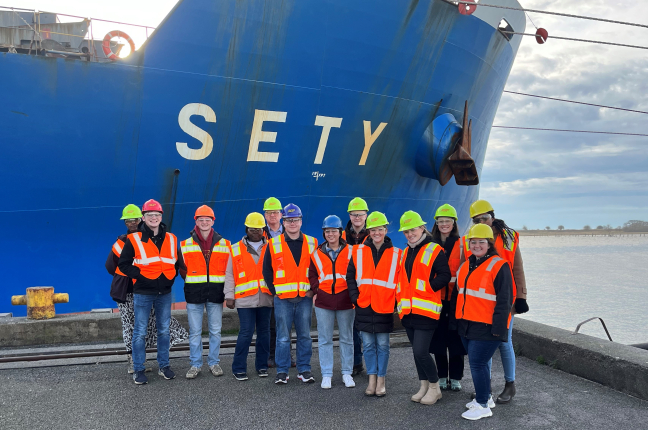
An Iowa State University agricultural business class studying the supply chain for soybeans visiting the AGP soybean meal port facility in Grays Harbor, Washington. Photo courtesy of Bobby Martens. Larger image.
AMES, Iowa – Many Iowa State University students studying agribusiness have seen a harvest hauled to market. Far fewer have witnessed what happens next.
“Even if you’re familiar with the business side of farming, it’s not apparent where crops go. You dump a load at the local co-op elevator, and it’s just gone. But it’s not just marketing. Grain physically needs to go somewhere,” said Bobby Martens, associate professor of economics and the Iowa Institute of Cooperatives Endowed Economics Professor.
A group of Iowa State students recently got a firsthand look at the path soybeans can take after they leave the elevator as part of an experiential course studying agricultural supply chains, a class centered in its inaugural year around a weeklong trip that stretched from processing and fuel plants in Iowa and Minnesota to ports in the Pacific Northwest.
It’s an interesting time to study soybean supply chains because they’re in flux, Martens said. Demand is rapidly ramping up for renewable diesel, a fuel that produces less carbon than traditional diesel while providing nearly identical performance. Soybean oil is needed for the expanding number of renewable diesel refineries, driving a subsequent boom in domestic processing. Increasing U.S.-based processing impacts livestock production, as crushing more soybeans here boosts the supply of soy meal used as animal feed.
“In the next few years, much more of our soybean harvest is going to be crushed here in the United States instead of being shipped overseas whole. They are building crush plants across the country. That will bring a whole gamut of supply chain changes,” Martens said. “There’s a transformation coming in the soybean sector, and everyone is getting set up for it now. These students will have such a leg up in understanding the changes.”
Cooperatives’ role
Member-owned cooperatives are playing a major role in reshaping the soybean market and were the focus of the trip, Martens said. That included stops at AGP’s soybean crush facility in Eagle Grove, biodiesel plant in Algona and export terminal in Grays Harbor, Washington. In Minnesota, the group visited a CHS processing plant in Mankato and its corporate headquarters in Inver Grove Heights before touring an export facility CHS jointly runs with Cargill in Kalama, Washington.
“Sometimes when people think of a co-op they think of a single elevator at the end of Main Street in a small town, but these are not elevators at the end of Main Street,” Martens said. “These are the organizations that have stepped up to take risks ahead of time because their business structure allowed them to position themselves to create opportunities. And the profits they make are going back to local farmers, ultimately.”
The cooperatives they visited gave students broad access to both their facilities and employees, with in-depth behind-the-scenes tours and briefings with executives and other leaders. Martens said he was blown away by how generous CHS CEO Jay Debertin was with his time, spending 90 minutes talking with the student group.
“These students did an amazing job representing Iowa State. I think everyone they interacted with came away impressed with the knowledge they had,” Martens said.
Up close, it clicks
The 11 students in the one-credit course, a mix of undergraduates studying agricultural business and graduate students in agricultural economics, attended several class sessions in the fall semester before the Dec. 13-19 trip. In the pre-departure classes, they heard from experts on soybean markets, exports, supply chains and cooperatives. Watching soybeans flow through the supply chain, however, had a bigger impact than learning about it in the classroom, said Nolan Mueller, a senior in agricultural business from Gilbert.
“It really clicks faster when you actually see it,” he said.
The on-the-ground perspective helped Katelyn Cook, a senior in agricultural business, truly grasp the scale of agricultural shipping lines.
“That was just kind of wild to me,” said Cook, who grew up on a small family farm near Belle Plaine. “Until you see it in person, the size of it is unbelievable.”
Before the trip, Mueller was most interested in seeing a crushing plant. But he ended up being fascinated by the export terminals.
“Hundreds of semis and trains are coming in and out every day,” he said. “There’s a lot going on in a really small space. It’s controlled chaos.”
Similar trips planned
Cook and Mueller plan to go on to graduate school after they earn their bachelor’s degrees this spring, and both are newly considering incorporating supply chains or soybeans into their future studies. Martens said that’s a big reason that cooperatives supported the study trip, including a donation from CoBank, a national cooperative bank.
“This is a good deal for the cooperatives because they want students to understand this is an evolving and interesting space with a lot of job opportunities,” he said.
Martens plans to offer a similar class next fall, focused on a different agricultural supply chain – tracing corn down Mississippi River barges or exploring fertilizer sourcing, for instance.
“We hope this is the first of many trips like this,” he said. “It’s such a valuable experience for students.”